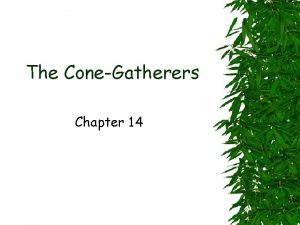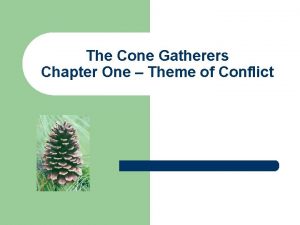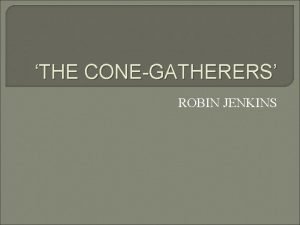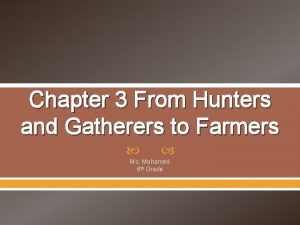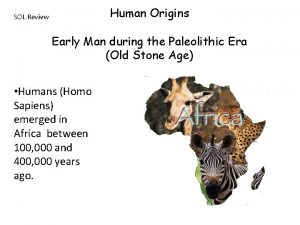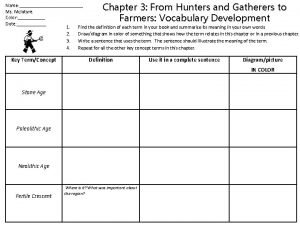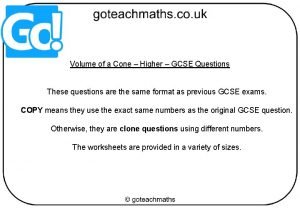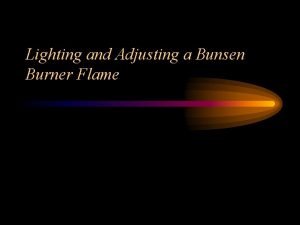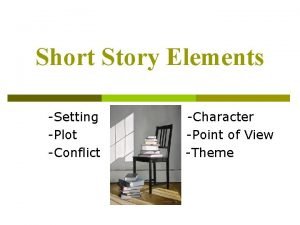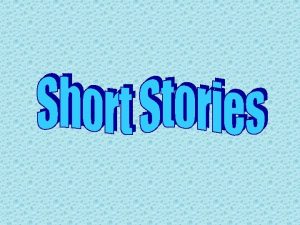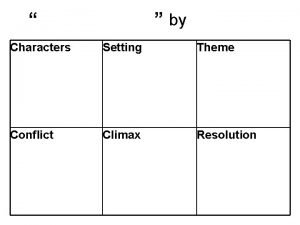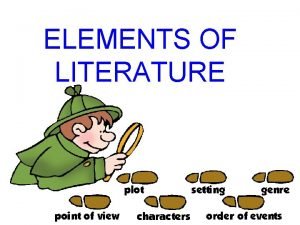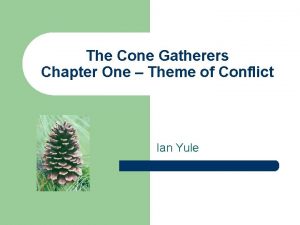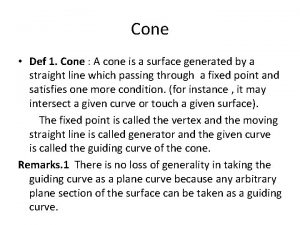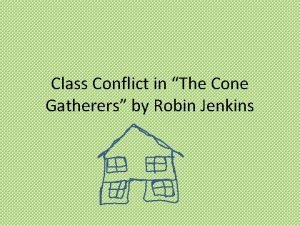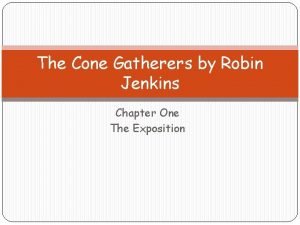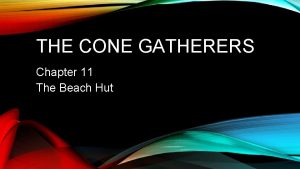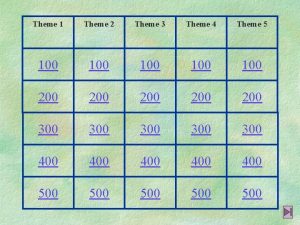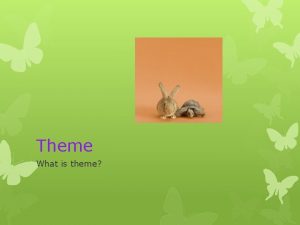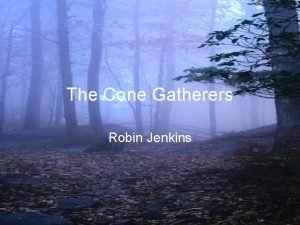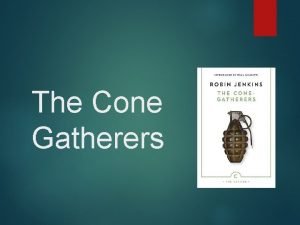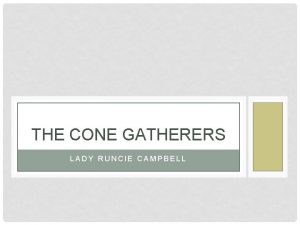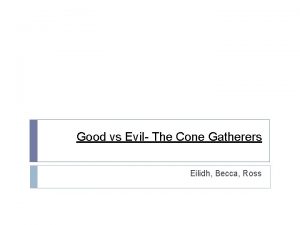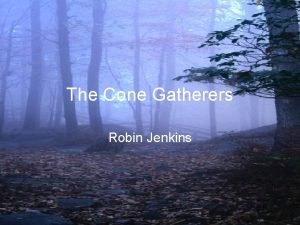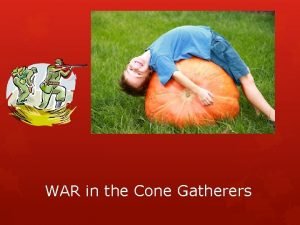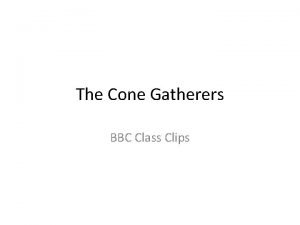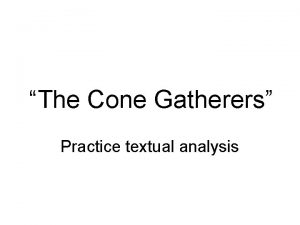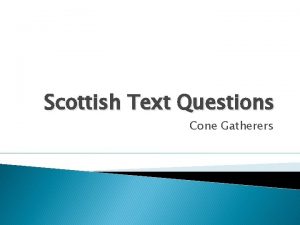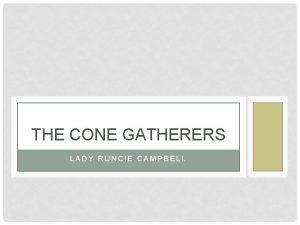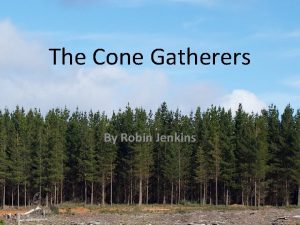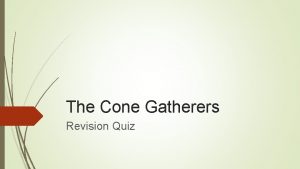The Cone Gatherers Chapter One Theme of Conflict





























- Slides: 29

The Cone Gatherers Chapter One – Theme of Conflict

Opening chapters The opening chapter of the novel is extremely important in immediately establishing a key theme in the text, which continues to run and develop through the entirety of the novel: Conflict The theme of conflict is actually presented to us in different ways.

Conflict in the SETTING The beautiful ‘Garden of Eden’ style woodland:

Techniques 1: Word choice: “It was a good tree by the sea loch, with many cones and much sunshine; it was homely too” Creates a positive atmosphere

Techniques 2: Simile “its topmost branches as comfortable as chairs” Suggestion of the forest being home for the CGs – especially Calum Sentence Structure The long sentence which builds up the idea of perfection is placed at the start of the chapter.

Conflict in the SETTING Into this perfect setting (microcosm) the evils of World War 2 (macrocosm) begin to creep in:

Techniques (1): Alliteration: “the sun slip” “a destoyer had steamed seawards with a sailor singing cheerfully” “aeroplanes had shot down from the sky” Highlights time period Negative connotations that foreshadow violence. Naivety of sailor similar to Calum

Techniques 3: Onomatopoeia: “gunshots had cracked far off in the wood War may be far off but danger is closer than you think

Techniques 4: Imagery: “daylight announced it must go: there was a last blaze of light, an uncanny clarity, a splendour and puissance; and then the abdication began. ” Day ends and night falls, darkness appears Mirroring of the battle between good and evil Adds to the tension in the atmosphere

A further contrast inside the SETTING The conflict between rich and poor The Rich “mansion” “the great house”

A further contrast inside the SETTING The Poor Images “a greasy shed” “hardly bigger than a rabbit hutch” Assonance “the ground about was filthy with their refuse and ordure”

The symbol of the division between rich and poor “private fence of giant silver firs”

Look at all the connotations: “private fence of giant silver firs” “private” – the poor are to be kept out “fence” – there is a barrier between rich and poor “giant” – the division is huge “silver” – suggestions of wealth”

Conflict in CHARACTERISATION Calum An innocent character in touch with nature “chaffinches fluttered round him” Connotations with St Francis of Assisi

Calum “his sunburnt face was alert and beautiful with trust” “he (Neil) knew what Calum represented, pity so meek” “on the misshapen hump of his body sat a face so beautiful and guileless to be a diabolical joke” Note the use of oxymoron to draw our attention to Calum’s face and the juxtoposition between his beautiful nature on the inside and his hideous shape on the outside

John Duror The personification of evil in Ardmore forest, much like the serpent in the Garden of Eden A metaphor is used to describe his growing hatred of the Cone Gatherers: “the overspreading tree of revulsion in him”

“the overspreading tree of revulsion in him” Look at the connotations in this expression: “overspreading” – it will touch a number of things / people around it “overspreading” – it will cast shade / darkness “tree” – it has roots (“but he (Duror) could not tell the force which made it grow”) “revulsion” – a powerful word for dislike

The roots “Since childhood Duror had been repelled by anything living that had imperfection or deformity or lack” Roots – in particular where evil comes from / what causes humans to do dreadful things – is a major theme in the book This is drawn out by the title ‘The Cone Gatherers’ – cones are seeds from which trees grow

His obsessive dislike: “He had waited over an hour to see them pass” “Duror was alone in his obsession” “but in him was a force more powerful than common sense or pride. He could not name it, but it dragged him irresistibly down towards that hut”

His fantasy: “He saw himself returning, kicking open the door, shouting at them in disgust, and then blasting them both to everlasting perdition. He felt an icy hand on his brow as he imagined that hideous but liberating fratricide. ”

Note the word choice (verbs): “He saw himself returning, kicking open the door, shouting at them in disgust, and then blasting them both to everlasting perdition. He felt an icy hand on his brow as he imagined that hideous but liberating fratricide. ”

Note the outcome: “He saw himself returning, kicking open the door, shouting at them in disgust, and then blasting them both to everlasting perdition. He felt an icy hand on his brow as he imagined that hideous but liberating fratricide. ” Duror believes that killing the Cone Gatherers (in particular Calum) will set him free from the growing internal conflict This fantasy sequence foreshadows the violent end of the novel.

Key incidents A number of key incidents bring out theme of conflict Two are worth reflecting on: The conflict over what to do with the rabbit caught in the trap The scene at the Cone Gatherers’ hut at the end of the chapter

The rabbit in the trap “it pounded on the grass making choking noises”

Issues “both front paws are broken” “it would not be able to run” “it would be at the mercy of its many enemies” It would be a kindness to kill it but Calum is unable to kill: “I couldn’t, Neil. ” This creates internal conflict (“sobbing in his quandary”) in Calum – he wants a good option but there are none.

Duror has no such quandary – this is yet another contrast with Calum’s compassion is contrasted with Duror’s lack of it. “When he did kneel, on one knee, to break the rabbit’s neck with one blow, it was like an act of sacrifice, so swift, so efficient, and somehow so purposeful. ” Note Jenkins’ use of alliteration of the letter ‘s’ to draw our attention to the cold killing of the rabbit.

The closing scene A contrast is drawn between the quiet homely life of the two brothers and the inner turmoil and propensity for evil that lies within Duror : The meal of potatoes Neil reading the paper Calum skilfully carving a squirrel Duror watching/imagining them, plotting his next move

“To Duror it had been the final defeat that such an ability should be in a half-man, a freak, an imbecile. He had read that the Germans were putting idiots and cripples to death in gas chambers. Outwardly, as everybody expected, he condemned such barbarity; inwardly, thinking of idiocy and crippledness not as abstractions but as embodied in the crouchbacked conegatherer, he had profoundly approved. ”

Contrast the homely scene with what was going on in Duror’s mind “He saw himself returning, kicking open the door, shouting at them in disgust, and then blasting them both to everlasting perdition. He felt an icy hand on his brow as he imagined that hideous but liberating fratricide. ” “Surely their deaths … could not be called murder” Duror’s final solution for the cone gatherers is compared to Hitler’s final solution for the Jews.
 The cone gatherers chapter summary
The cone gatherers chapter summary The cone gatherers summary
The cone gatherers summary The cone gatherers summary
The cone gatherers summary From hunters and gatherers to farmers chapter 3 answers
From hunters and gatherers to farmers chapter 3 answers 10 importance of agriculture
10 importance of agriculture Hunters and gatherers
Hunters and gatherers Hunters and gatherers
Hunters and gatherers A cone has a volume of 98cm3 the radius of the cone is 5.13
A cone has a volume of 98cm3 the radius of the cone is 5.13 Bunsen burner steps
Bunsen burner steps One empire one god one emperor
One empire one god one emperor One one one little dogs run
One one one little dogs run One king one law one faith
One king one law one faith One empire one god one emperor
One empire one god one emperor One ford
One ford See one do one teach one
See one do one teach one See one, do one, teach one
See one, do one, teach one Twelfth night speeches
Twelfth night speeches Studiendekanat uni bonn
Studiendekanat uni bonn One vision one identity one community
One vision one identity one community One vision one identity one community
One vision one identity one community Whats external conflict
Whats external conflict What is conflict and conflict resolution?
What is conflict and conflict resolution? Externalconflict definition
Externalconflict definition Theme d religion peace and conflict
Theme d religion peace and conflict What is the climax of the story the lion and the mouse
What is the climax of the story the lion and the mouse Setting in a short story
Setting in a short story Setting of the story
Setting of the story Zoo by edward d. hoch theme
Zoo by edward d. hoch theme Short story definition in literature
Short story definition in literature Hình ảnh bộ gõ cơ thể búng tay
Hình ảnh bộ gõ cơ thể búng tay
